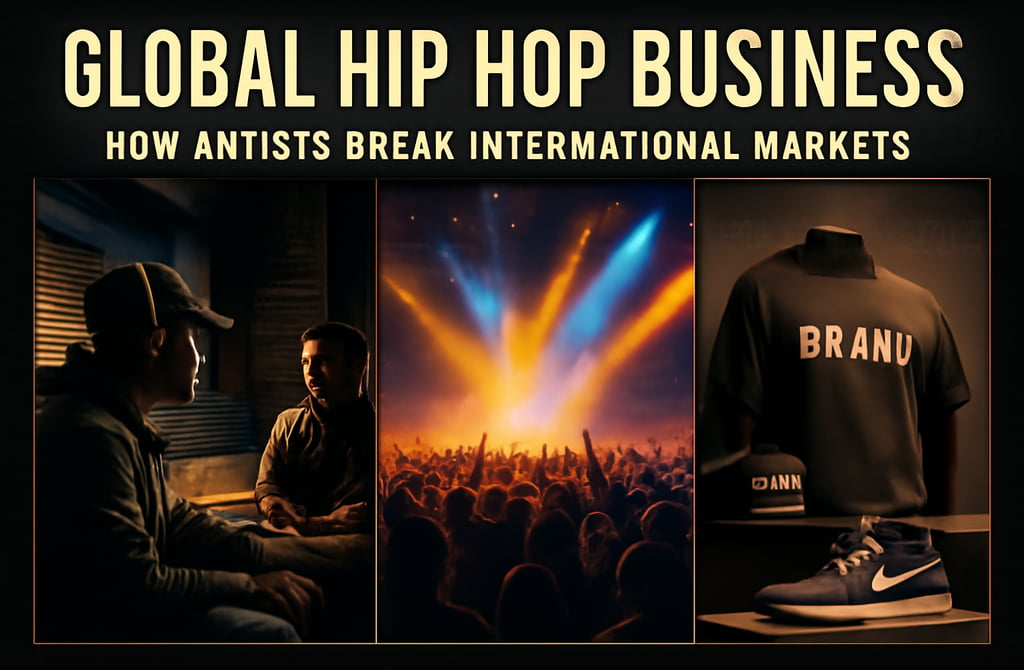Global Hip Hop Business: How Artists Break International Markets
8/17/20253 min read


Hip hop’s ascent from local street culture to a multibillion-dollar global industry reflects its adaptability, entrepreneurial spirit, and power to connect across languages and borders. Artists today leverage strategic partnerships, digital platforms, and regional insights to expand beyond home markets and cultivate worldwide fanbases. Here’s how they do it:
1. Leveraging Digital Distribution and Streaming
Bypassing traditional gatekeepers, artists upload tracks directly to Spotify, Apple Music, YouTube, and regional services like Boomplay or Gaana. Curated playlists, algorithmic recommendations, and social media virality turn local hits into global phenomena almost overnight. Strategic release timing—dropping singles on Fridays to maximize chart impact—and targeted metadata (language tags, region codes) ensure tracks reach both domestic and international audiences.
2. Strategic Collaborations and Cross-Market Features
Partnering with established artists in target markets lends credibility and access. For example, a South Korean rapper teams up with a U.S. hip hop heavyweight, exposing both fanbases to new sounds. In Latin America, Brazilian MCs collaborate with Spanish-language acts to bridge Lusophone and Hispanic audiences. Regional guest features on remixes help tracks climb foreign charts and signal authenticity to local listeners.
3. Touring and Live Events as Market Entry
Live performances remain critical for building loyal followings. Artists often debut in nearby markets—Indian rappers touring Southeast Asia or European artists hitting North Africa—before tackling larger regions. Festival slots at events like Afro Nation, SXSW, and Rolling Loud expose them to diverse crowds, creating press buzz and driving streaming numbers. Popup “cypher” showcases in major cities generate grassroots excitement and social-media content.
4. Localization: Language, Imagery, and Storytelling
Understanding cultural nuances is vital. Lyrics may incorporate local slang or reference regional issues. Music videos showcase familiar landmarks or traditional attire, weaving local aesthetics into hip hop’s visual language. Social media posts celebrate regional festivals or respond to local trends—demonstrating cultural respect and building genuine connections.
5. Brand Partnerships and Endorsements
Major brands—Nike, Adidas, Red Bull—sponsor global hip hop tours, album rollouts, and branded cypher events. Emerging artists align with lifestyle brands (streetwear labels, sneaker boutiques) for co-branded capsule collections, limited-edition merch, and social media campaigns. These collaborations provide financial backing and serve as marketing accelerants in unfamiliar markets.
6. Independent Label Networks and Joint Ventures
Rather than signing exclusively with a global major, many artists form joint ventures: a local label retains creative control while partnering with an international distributor or major imprint for marketing muscle abroad. This hybrid model balances artistic autonomy with the infrastructure needed for billboard campaigns, radio promotions, and playlist pitching in key territories.
7. Data-Driven Market Targeting
Analytics platforms track streaming demographics, playlist placements, and social-media engagement by region. Artists and their teams identify emerging hotspots—cities where a song is unexpectedly popular—and deploy localized marketing pushes, such as geo-targeted ads, region-specific remixes, or pop-up performances.
8. Cultural Diplomacy and Social Impact
Governments and NGOs increasingly recognize hip hop’s soft-power potential. Initiatives like cultural exchange programs, youth workshops, and cross-border cypher events position artists as cultural ambassadors. Such programs provide visas, grants, and media support, smoothing logistical hurdles for international expansions.
9. Monetization Beyond Music
Diversifying revenue streams is key. Artists launch podcast series, fashion lines, book deals, and branded digital collectibles (NFTs) tailored to global audiences. Virtual concerts and metaverse appearances extend reach without the cost of physical tours, offering exclusive experiences to fans worldwide.
10. Future Trends: Emerging Markets and Hybrid Genres
As hip hop gains traction in regions like West Africa, Southeast Asia, and Eastern Europe, new subgenres emerge—Afro-trap, K-hip hop, desi drill—each with unique market dynamics. Forward-thinking artists and labels will invest in regional A&R, bilingual lyricists, and cross-continent talent incubators to stay ahead in the competitive global landscape.
Conclusion
Breaking international markets in hip hop requires a fusion of creativity, cultural intelligence, and business acumen. By mastering digital platforms, forging strategic alliances, and adapting to local tastes, artists transform local street anthems into global chart-toppers—expanding both their artistic impact and commercial reach across continents.

🎶 Get The Bars, The Beats, The Backstories – Direct to Your Inbox.
Send your Articles
Stay updated with the latest hip hop trends.
Stay Connected
rap@grillg.com
+91-9911428513
© 2024. All rights reserved.
